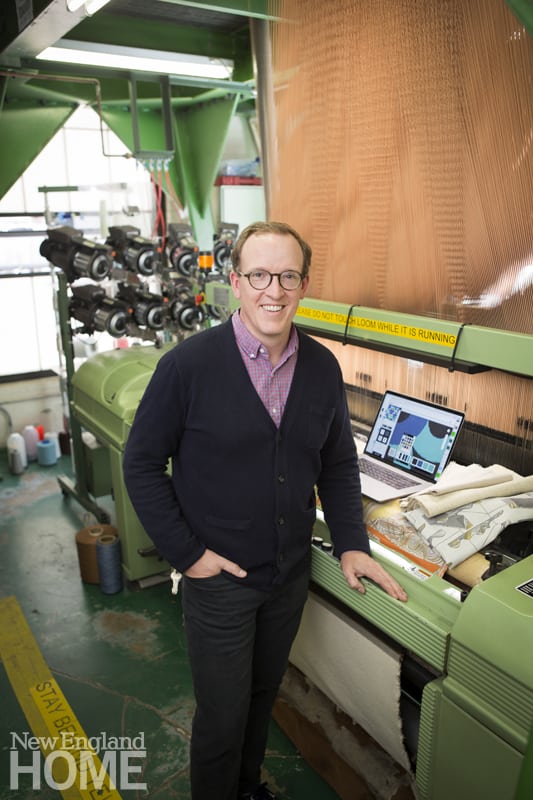Five Questions: Brooks Hagan
August 14, 2018
Textile expert Brooks Hagan hopes his new Providence company, Weft, will revolutionize fabric design.
Text by Robert Kiener Photography by John Soares

1. Weft features an online application that lets designers transform artwork into fabric. What was your inspiration?
I am a textile designer by training, and for more than twenty years, I have watched the textile industry go through dramatic changes as mills closed and manufacturing moved offshore. Prior to becoming a full-time professor at RISD, I worked at a fourth-generation textile mill in New York City and was there the day it closed. That got me thinking about what could be done to preserve and bring back that expertise we have lost. One day, as I was watching a Pixar animated movie with my children, I noticed the realistic way the graphic designers had rendered the fabric. I began to wonder, could we apply some of these same graphic skills to a design process that helps textile designers and manufacturers?
2. How did you make the leap from an animated movie to a new design application?
I teamed up with my now-partner, Steve Marschner, a professor of computer science at Cornell. He is known for his work advancing the realism of computer graphics animation, and has won an Academy Award for technical achievement. We agreed to see if we could take what he was doing with computer graphics and adapt that to manufacturing textiles. Combining our expertise in textiles and digital technology, we developed an online design application, Weft, that lets anyone transform artwork into a piece of custom woven fabric. Our rendering technology allows you to see exactly, down to the individual thread, how that fabric will look. The result is then sent to one of our weaving partners—all in the U.S.—who produces the fabric on Jacquard looms. You can do all this and have the fabric in your hand in three weeks or less.
3. So Weft is a sort of digital loom?
Exactly. We feel it is a bit of a radical step because we are saying, “This is such an accurate representation of real-world materials that you can make design decisions based on it.” There have been attempts at this before, but our techniques are so much better and the processing is much faster. Our application works on any web browser. You don’t have to download software; it is instantaneous. Also, it is not just for fabric designers; users don’t have to be trained in the complexity of textile production. It is our hope that Weft will drive energy and interest toward deeper, more specialized areas of textile design, resulting in more custom fabric and more artisanal work.
4. So, for example, homeowners could design their own fabric?
Yes, anyone can. We can produce as little as three yards (for less than $100) to 3,000 yards or more. The existing textile industry is in some ways very curated; every time a fabric changes hands, it is marked up, and there really is not much access to the means of production. Our hope is that letting people do things directly might lead to some new design ideas, some fresh perspectives of the sort that we may never have seen before. In fact, we are already seeing that. No one need be locked into the existing library or catalog of designs that is on the market. Artists, graphic artists, interior designers, students, and even homeowners can now become fabric designers. We are also going to offer an archive of ready-to-go designs that can be recolored, and we offer a sample book of our available fabrics, because no matter how good the renderings are, you still want to know what a fabric feels like.
5. Can Weft help reinvigorate today’s textile industry?
My first focus and concern is to help preserve what remains. I do feel it’s almost as if we cannot do enough, fast enough, but it has to happen at its own pace. The more different types of fabric we can produce for people to work with and try, the more I think we can help establish an appreciation for the art form. Hopefully, this will eventually drive more business into the sector. The more enthusiasm and commitment we can generate about the process of textile manufacturing, which has to happen by creating better access, the more people will care about supporting this industry.
Weft, Providence, weft.design
Share
![NEH-Logo_Black[1] NEH-Logo_Black[1]](https://b2915716.smushcdn.com/2915716/wp-content/uploads/2022/08/NEH-Logo_Black1-300x162.jpg?lossy=1&strip=1&webp=1)







You must be logged in to post a comment.